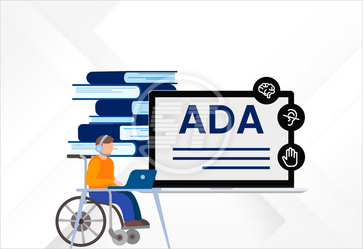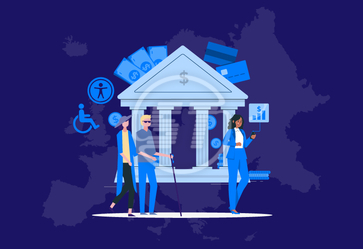The world has transformed into a digital-first environment, wherein accessibility can’t be skipped by organizations, businesses, and charities (non-profits), for that matter. Since no industry is left untouched by the influence of technology, people are dependent on digital platforms for every tiny-mini task.
With new and evolving digital accessibility standards, likewise other industries, non-profits or charities also ensure their websites, applications, and other online content are inclusive for all users.
This article focuses on how charities can meet accessibility requirements, enhance user experience, and cater to people in need.
Digital accessibility and its importance for charities!
Digital accessibility refers to designing and developing digital content so that people with disabilities can perceive, understand, navigate, and interact with it effectively. Many countries have incorporated WCAG into their legal frameworks, requiring every organization (including non-profits) to comply with these standards.
Charities exist to serve communities with inclusivity is at the heart of their mission. Ensuring digital accessibility enables non-profits to connect with a broader audience, including individuals with disabilities. Since users with disabilities otherwise feel excluded from essential services and information.
An essential digital presence also fosters stronger donor relationships by demonstrating a commitment to equal access for all. Furthermore, it ensures compliance with legal requirements, avoiding potential legal challenges and reputational risks. In short, digital accessibility is a crucial step toward fulfilling a charity’s core mission of serving and engaging with diverse communities.
Charities can achieve digital accessibility by adhering to best web practices!
- Conduct an accessibility audit
Before making required improvements, organizations should assess their current digital platforms for accessibility gaps. This can be done using automated tools like Website Accessibility Checker by Skynet Technologies, WAVE, or axe, as well as expert manual testing.
- Adopt WCAG principles
The WCAG standards focus on four core principles: Perceivable, Operable, Understandable, and Robust. Thus, the website or application should have readable content (including text, images, and videos). It must have keyboard-friendly navigation along with a clear and predictable structure. And content ought to be compatible with various assistive technologies.
- Optimize website design and content
Adhere to WCAG best practices to create accessible web designs or remediate them. Such as ensuring links and buttons are large enough and clearly labeled, multimedia content has transcripts and audio descriptions, error messages don’t rely solely on colors, and many more.
- Implement AI features along with compatibility for various assistive technologies
Charities/non-profits should work on screen readers’ compatibility and voice command assistance to improve the overall accessibility of the websites or applications. Also, adding AI-powered chatbots with voice and text support enhances user engagement.
- Train staff and volunteers
Ensuring that team members understand best practices for digital accessibility is crucial. Conduct training sessions on writing accessible content, designing user-friendly interfaces, and troubleshooting accessibility issues.
- Regular testing and feedback
Accessibility is an ongoing process. If users with disabilities are part of testing team, nothing like it, because it will help identify and resolve real pain-points. Encourage feedback through surveys and contact forms to continuously improve accessibility.
Challenges encountered by charities in implementing digital accessibility!
While digital accessibility is essential, non-profits often face several challenges in achieving compliance:
- Limited funding and resources
Many charities operate on tight budgets, making it difficult to invest in accessibility improvements and tools.
- Lack of awareness
Many remotely operated charities (or others) may not fully understand accessibility requirements and their legal obligations.
- Technical barriers
Ensuring compatibility with assistive technologies, updating to the latest versions every time and maintaining accessible digital content can be complex and require expertise.
- Resistance to change
Some charities may struggle with prioritizing accessibility due to competing operational demands.
Addressing these challenges requires strategic planning, collaboration with accessibility experts, and leveraging available grants or funding options to support digital inclusion initiatives.
Benefits of digital accessibility for non-profits/charities!
- Expanded reach
Accessible websites allow a wider audience, including people with disabilities, to engage with the organization’s mission.
- Enhanced reputation
Demonstrating a commitment to inclusivity strengthens credibility and attracts more supporters.
- Legal compliance
Meeting accessibility requirements reduces the risk of legal repercussions and ensures adherence to regulatory standards.
- Improved user experience
Accessibility improvements benefit all users, including those using mobile devices or experiencing temporary impairments.
In a nutshell,
As digital accessibility becomes a global priority, non-profits/charities must take proactive steps to comply with new accessibility standards. By implementing inclusive practices, charities can create a genuinely equitable digital space, promote engagement for everyone, and help people from various regions.
Accessibility is not a problem to be solved. It is a culture to be built.- Sheri Byme-Haber
And charities are the best places to begin building accessible digital world!
Ready to make your website inclusive and compliant? For non-profits and charities, bridging the digital divide isn't just a mission—it's a responsibility. Partner with accessibility remediation experts who understand your goals and can help bring your digital presence up to current accessibility standards. Let us support your efforts with cost-effective, reliable solutions that make a lasting impact. Start your digital accessibility journey with All in One Accessibility. For more information, reach out [email protected].


